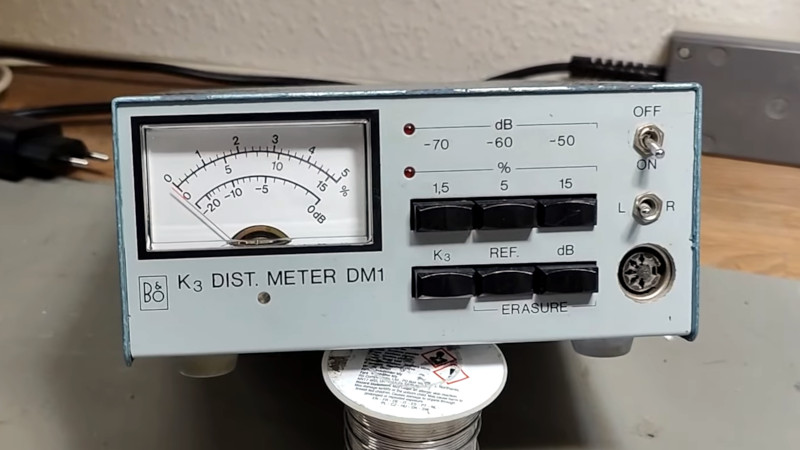An audio distortion analyzer is a specialist piece of analogue test equipment that usually costs a lot of money and can be hard to track down on the second hand market. Finding one is a moment of luck for the average engineer then, but [Thomas Scherrer OZ2CPU]’s discovery isn’t quite what he might have hoped for. Nonetheless, his Bang and Olufsen K3 Distortion meter DM1 from 1979 is still an interesting and high quality piece of test equipment, and the video below the break makes for a worthwhile watch.
Bang and Olufsen are best known for high-end design Hi-Fi units, thus it’s a surprise to find that in the past they also manufactured test equipment. This distortion meter isn’t a general purpose one, instead it’s designed to measure tape recorders in particular, and it uses an elegant technique. Instead of injecting a sine wave and removing it from what comes out in order to measure the products of the distortion, it records a 333 Hz sine wave onto a tape, then measures the strength of its 3rd harmonic at 1 kHz as an indication of distortion. It’s a working distortion meter made with clever analogue circuitry for a fraction of the cost of the more conventional models that HP would have sold you at the same time, even if it doesn’t give the same THD figure you might have been looking for.
If distortion interests you, it’s a subject we’ve looked at in the past.
















About old audio analyzer gears, i have a nice one to restore: a Meguro MK-668C Wow Flutter Meter, in rather good shape with its gorgeous japanese nixie tubes display.
But i’m unable to locate user and service manuals and schematics for this model anywhere. A Meguro company still exist, but they do not answer enquiry mails. If maybe somebody could help, even japanese written ones would be great!
“Bang and Olufsen are best known for high-end design Hi-Fi units”
Based upon a recent video of Techmoan I have a different perspective of the brand.
https://www.youtube.com/watch?v=xRWFH3tnWaY
After watching that video I can’t help to believe that B&O seems overly priced, dubious interfaced and the focus doesn’t seem to be on the high-end design of Hi-Fi units but more on the looks of it. In the past I thought differently, but I just didn’t know any people who owned such fancy and expensive equipment. So my thought were purely based upon the glossy adds, TV commercials and pretty looking devices in the shop windows. So the real question is perhaps, how well do we really know B&O and what is it really worth?
The Apple of the Hi-Fi world IMO.
My first job was as a repair tech in a brown goods repair shop.
B&O for a long time were pretty damn good at audio and TV, their in house designed stuff was really rather well built and performed (not worth the ludicrous premium prices but still, good).
Somehwere in the 80s they jumped the shark and became an integrator of OEM stuff, their CD players were the ubiquitous (and dubious, despite the golden ears BS you read now) crappy plastic Phillips CDM mechs and electronics that were sold to get CD technology into the market fast.
Their VCRs were either Phillips VR6462 plastic fantastic nightmares or rather more sturdy Matsushita/Panasonic NV-730, they shifted focus to concentrating on the design of the aesthetics rather than the electronics and mechanicals.
The funniest thing was listening to the gullible B&O lickspittles telling me how much better their B&O CD player sounded or how much better their B&O VCR looked and sounded when I *knew* with 100% certainty that it was just a bog standard Phillips or Panasonic OEM mech and electronics but in a fancy brushed aluminium/piano black box with a B&O badge and a B&O price tag.
“they shifted focus to concentrating on the design of the aesthetics rather than the electronics and mechanicals.”
Because there was little point to improving the electronics or mechanicals.
By the end of the 80s and early 90s we reached the point where “low end equipment” was damn near perfect and was as good as the environments they were actually used in.
Agreed, we got to a point where low and low-mid range audio gear was really good for very little money and you needed to spend an awful lot more money to gain ever smaller improvements in audio quality.
So, like a lot of ‘high end’ equipment manufacturers, B&O ended up with the only differentiator being overpriced cabinets and the badge they stuck on their products, neither of which add value or utility other than giving the owners something to boast about, instead of innovating and building better gear which is what they had been doing.
What they didn’t really change were their price tags.
wow what a fantastic video :-)